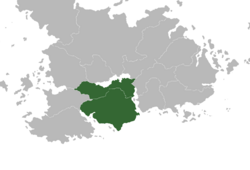User talk:Urcea/Concept
This article is a geographic placeholder stub intended to be integrated by new players. It describes the general situation of this territory and its relation to other countries. It should not be understood to be a freestanding country.
|
Calto | |
|---|---|
Region of Sarpedon | |
 Location of Calto (green) in Sarpedon (gray) | |
| Continent | Sarpedon |
| Historical Relations | |
| Possible cultures | Slavic Finno-Ugric |
| Area | |
| • Total | 259,000 km2 (99,999 sq mi) |
Calto is a region in south-central Sarpedon. It borders Volonia to the west, Caphiria to the north, Bertina to the south, and Russotto to the east.
Calto sits in Sarpedon's southern region, and its area was primarily settled by Slavic peoples, with some legacy influence of the Ancient Istroyan civilization. Much of Calto's pre-history and early history is largely defined by the presence of nomadic tribes who were ancestors of the Slavic people, similar to the rest of south-central Sarpedon. The critical change in this region came in the medieval period, as the region was subject to significant Caphiric influence, particularly during the Slavic-oriented Third Imperium part of Caphiria's history from 1283 through 1782. Due to longstanding Caphiric influence, as well as general trends throughout the continent, the people of Calto were likely historically Catholic.
Geography
Calto sits in the south-central portion of Sarpedon just south of Lake Parima. Its southern region and southern border is largely defined by the presence of the Parima Mountains and the runoff which forms rivers originating from it. Climatologically, Calto has a hot, mediterranean type climate, although most of the country is significantly temperate than the desert and desert-adjacent regions north of Lake Parima. The Calto region has an area of XXX,XXX square miles. This type of paragraph will be fully-fledged so that plebs can plug-and-play it into their geographic section without having to do much work beyond name changes. Since that's true, the rest of this will be placeholder text to give an idea of how a fully formatted GPS (geographic placeholder stub) article would look.
According to all known laws of aviation, there is no way a bee should be able to fly. Its wings are too small to get its fat little body off the ground. The bee, of course, flies anyway because bees don't care what humans think is impossible. Yellow, black. Yellow, black. Yellow, black. Yellow, black. Ooh, black and yellow! Let's shake it up a little. Barry! Breakfast is ready! Ooming! Hang on a second. Hello? - Barry? - Adam? - Oan you believe this is happening? - I can't. I'll pick you up. Looking sharp. Use the stairs. Your father paid good money for those. Sorry. I'm excited. Here's the graduate. We're very proud of you, son. A perfect report card, all B's. Very proud. Ma! I got a thing going here. - You got lint on your fuzz. - Ow! That's me! - Wave to us! We'll be in row 118,000. - Bye! Barry, I told you, stop flying in the house!
The Allied and Associated Governments affirm and Germany accepts the responsibility of Germany and her allies for causing all the loss and damage to which the Allied and Associated Governments and their nationals have been subjected as a consequence of the war imposed upon them by the aggression of Germany and her allies. ARTICLE: 232. The Allied and Associated Governments recognise that the resources of Germany are not adequate, after taking into account permanent diminutions of such resources which will result from other provisions of the present Treaty, to make complete reparation for all such loss and damage. The Allied and Associated Governments, however, require, and Germany undertakes, that she will make compensation for all damage done to the civilian population of the Allied and Associated Powers and to their property during the period of the belligerency of each as an Allied or Associated Power against Germany by such aggression by land, by sea and from the air, and in general all damage as defined in Annex l hereto.